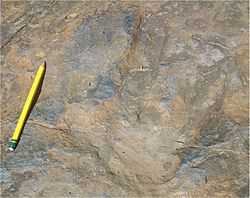Dinosaur Footprints
- This article is about a nature reserve; for fossil footprints, see Trace fossil; for their study, see Ichnology

The first dinosaur prints to be scientifically described are still able to be seen and have been preserved in sandstone. Hundreds of fossils are visible including those from the four distinct two-legged dinosaurs, but also stromatolites, fish, plants and other ancient beings. There is also a trackway, which formed the basis for the novel theory that dinosaurs traveled in packs or groups.
Fossils
As the name implies, fossil footprints are this park's main attraction. They were formed during the Early Jurassic period (approximately 200 million years ago) when what is now the Connecticut River Valley was a subtropical region filled with lakes and swamps. Bipedal, carnivorous dinosaurs up to 20 feet (6 m) long left footprints in the ancient mudflats. These tracks were fossilized and largely hidden until many were unearthed by the construction of what is now U.S. Route 5. The area was acclaimed by 19th century paleontologists for its abundance of fossil specimens, dinosaur tracks in particular, and the reservation is popular with the ichnologists that study them. There are 134 separate dinosaur footprints in the sandstone beds that flank the Connecticut River.[1]
This area was studied by Edward Hitchcock, the Amherst College professor who advanced the revolutionary notion that rather than being cold-blooded reptiles, dinosaurs were more like a sort of "reptilian bird." In the 1930s, a Springfield, Massachusetts newspaper poked fun at this notion by referring to the animals that left the fossilized footprints as "the Giant Turkeys of Prof. Hitchcock."[2]
Smith College professor William J. Miller wrote in his Geological History of the Connecticut Valley of Massachusetts:The largest numbers by far have been found at various localities in the general direction of Turner's Falls and South Hadley. In regard to the perfect preservation of such a vast number of geologically ancient animal tracks no district in the world is at all comparable with the Connecticut Valley ... In one case the writer is able to step, with a stride of about three and a half feet, in a series of eleven footprints, each about a foot long, exactly where a giant dinosaur left his foot print impressions on the original surface.
[2]

A dirt path leads from the reservation entrance to the footprints. Besides the clearly formed dinosaur tracks, visitors can see imprints left by prehistoric plants, invertebrate trace fossils and delicate ripple marks of an ancient pool preserved in stone near the river's west bank. Fossils in situ are located not only in the reservation itself, but on other land including a riverfront parcel owned by Holyoke Gas and Electric and managed cooperatively with the Trustees of Reservations and the Commonwealth.[1] There is also a place to see dinosaur tracks in nearby Granby, Massachusetts. Amherst College has a museum that displays the dinosaur footprints that were once found in South Hadley.[3]
Visiting
The reservation is open daylight hours from April 1 to November 30 and has educational programs for children.[1][4] For visitor safety, Guilford Transportation, which owns the railroad corridor, does not permit crossing of railroad tracks. As such, there is no legal access to the Connecticut River. Mountain biking is not allowed. Dogs must be kept on leash at all times.
A short trail parallels Route 5 northward from the entrance to the location of the dinosaur footprints and is easily walked.
See also
References
External links
| |||||||||||||||||||||||||||||||||||||||||||||
Coordinates: 42°14′30″N 72°37′24″W / 42.241682°N 72.623336°W